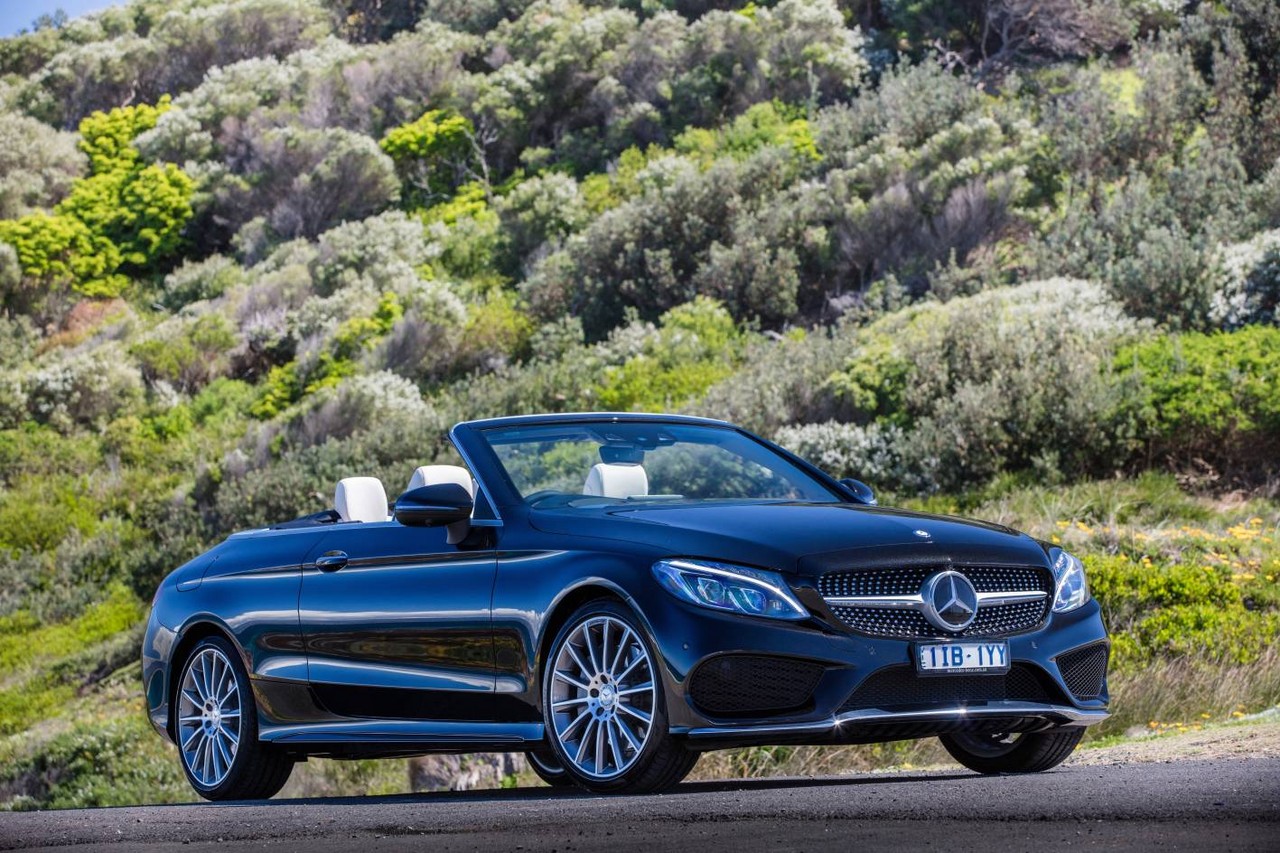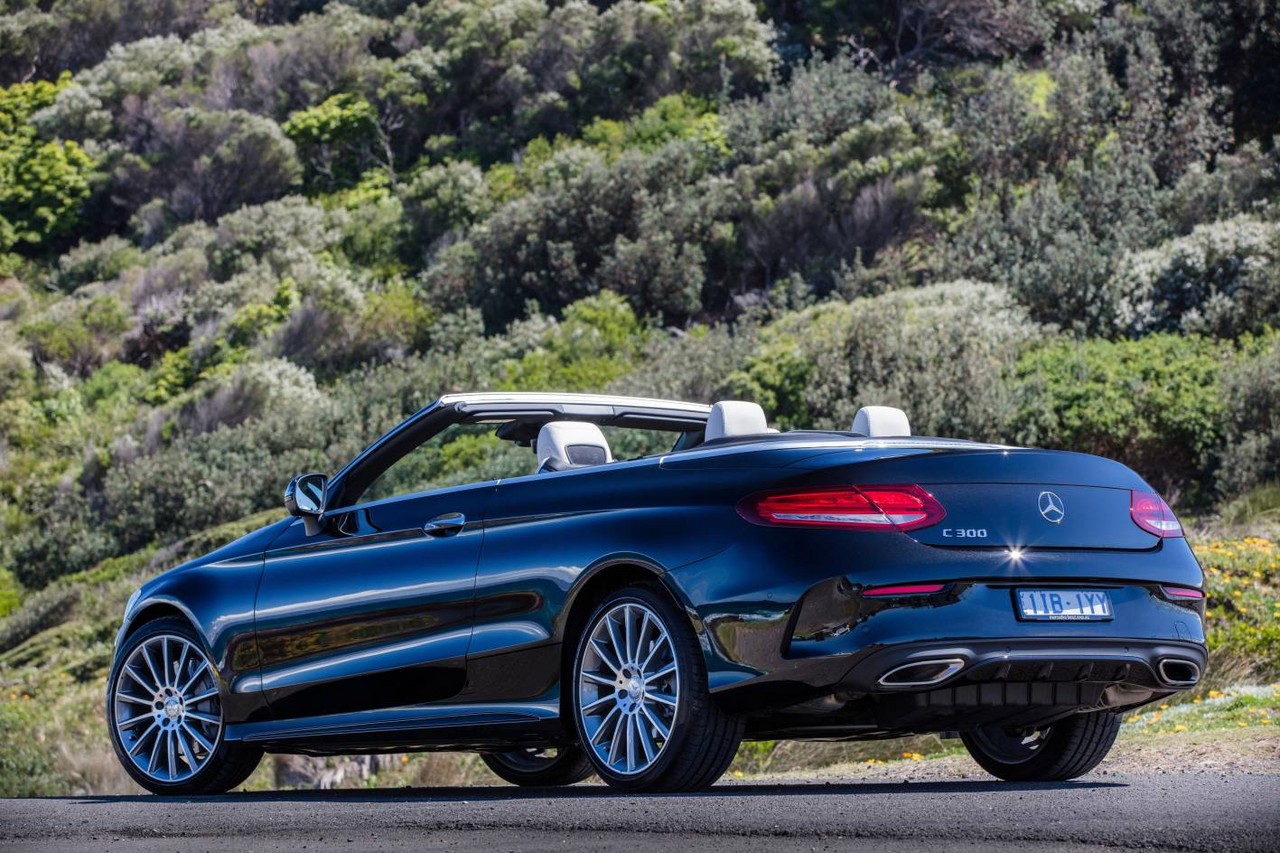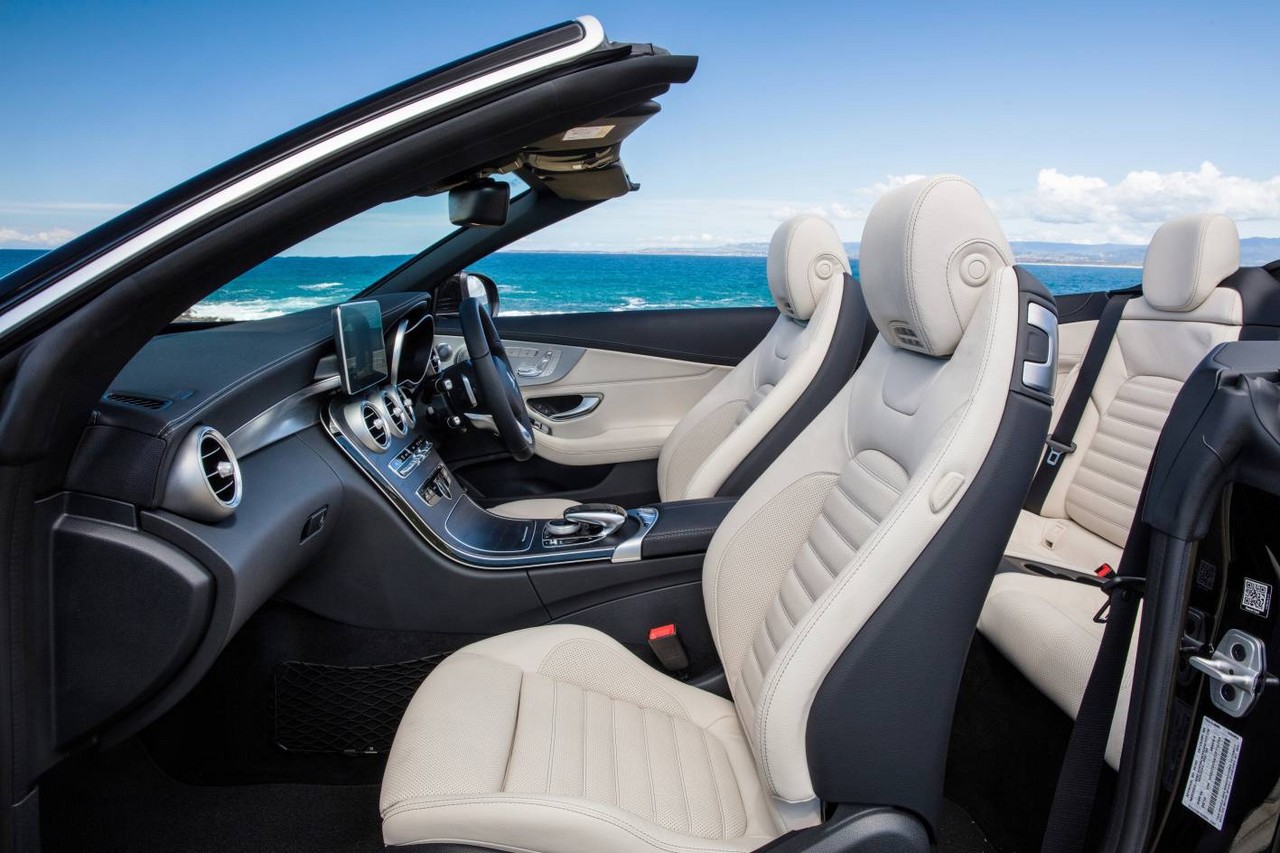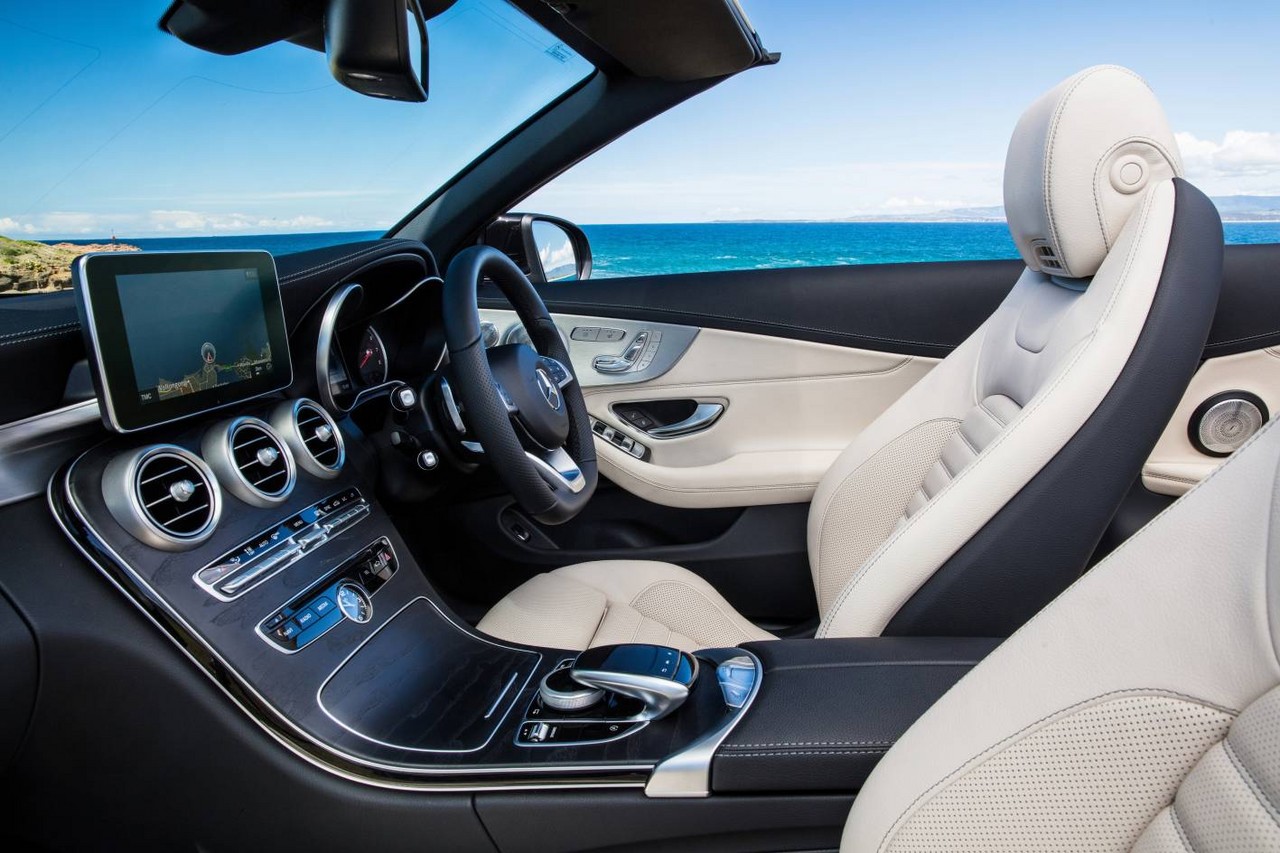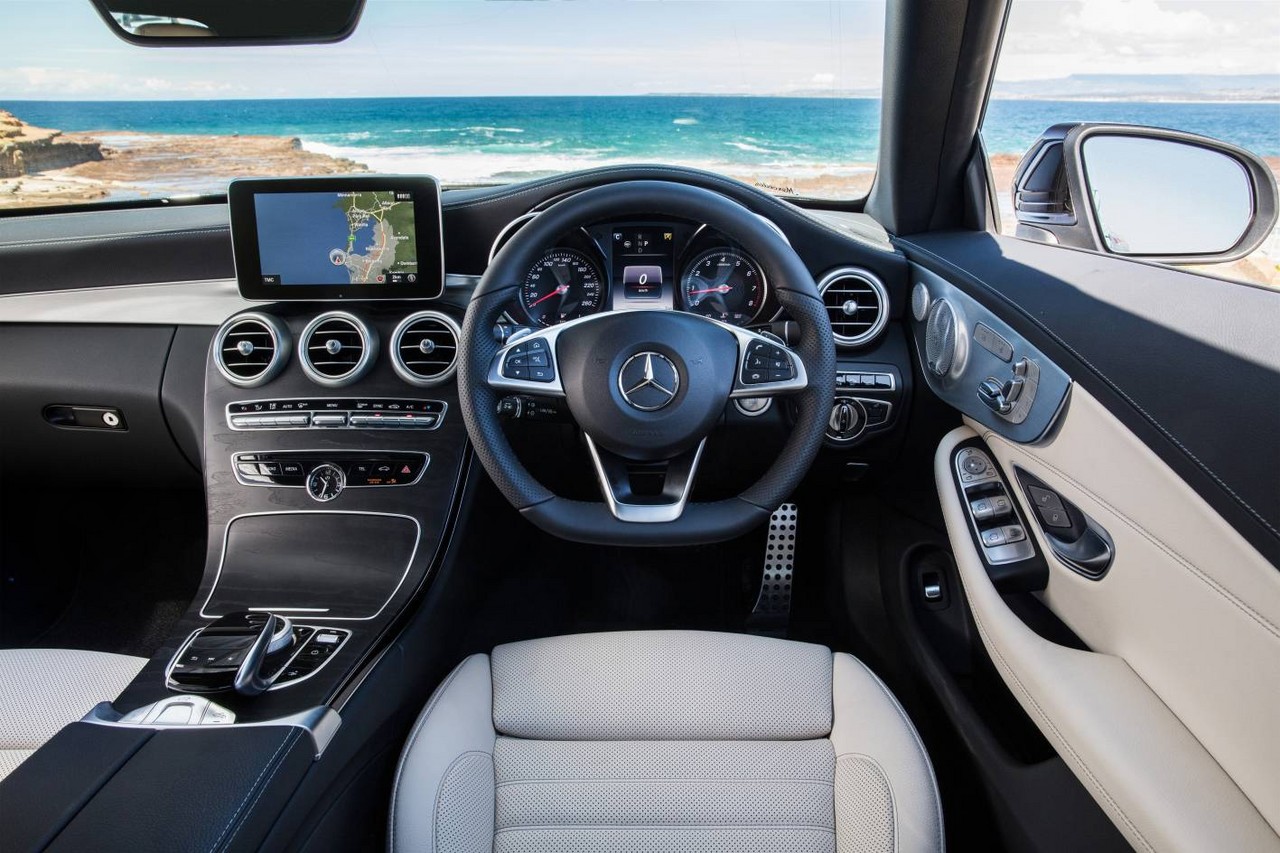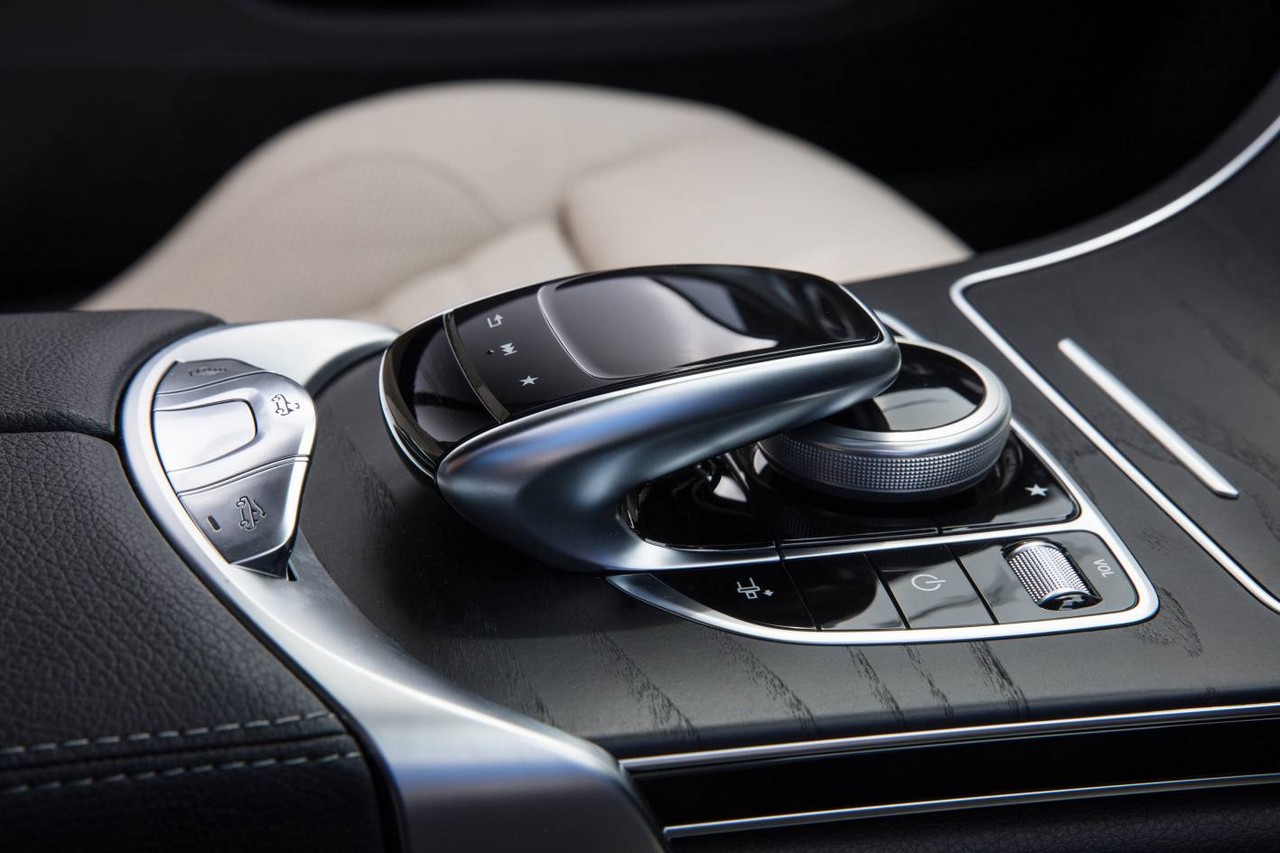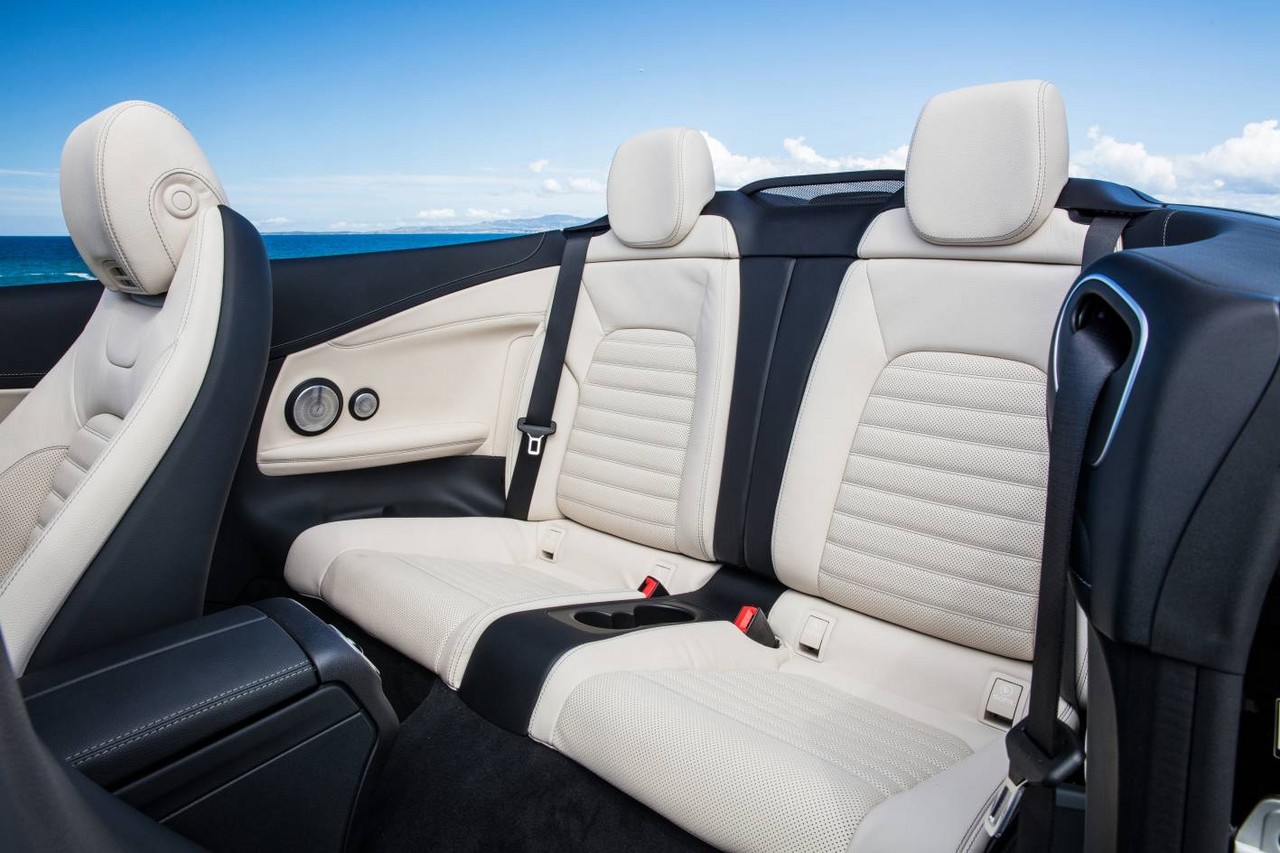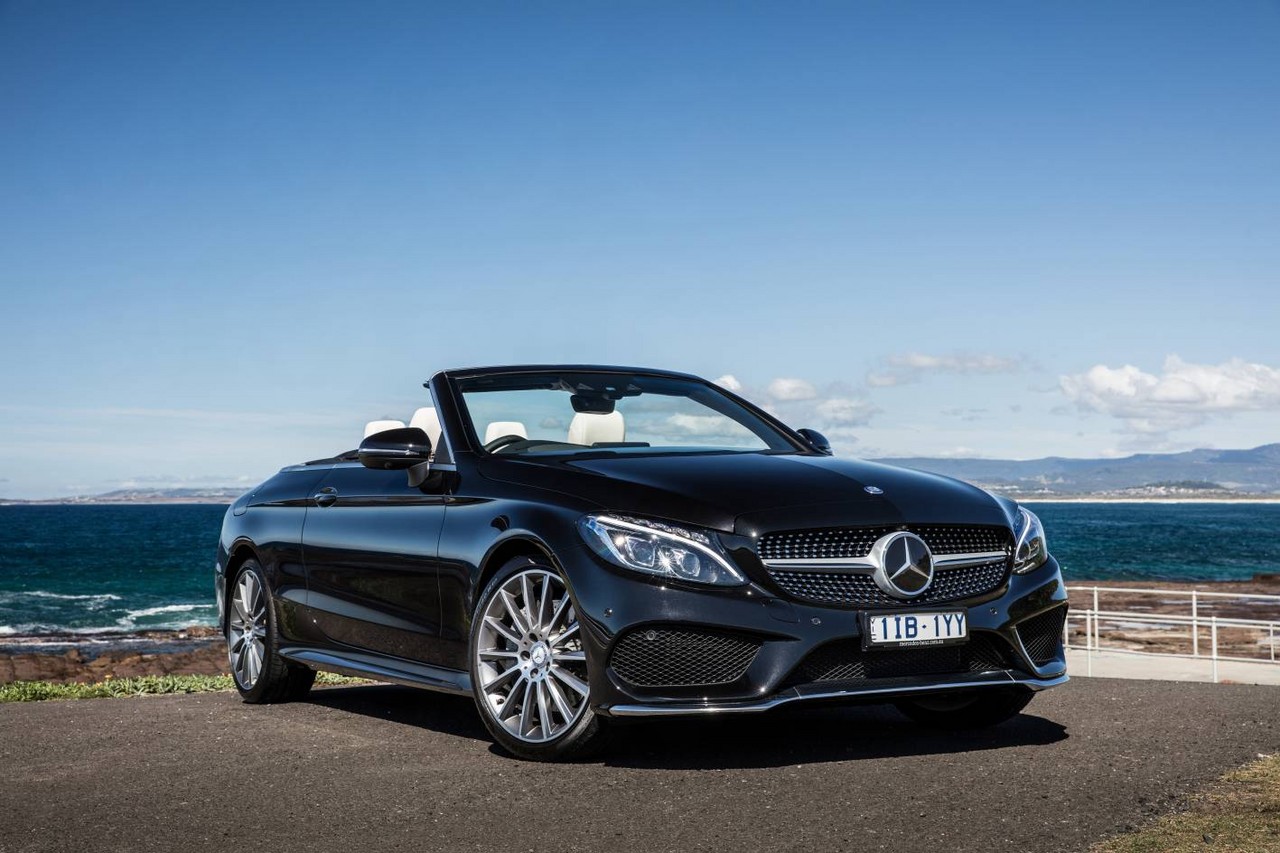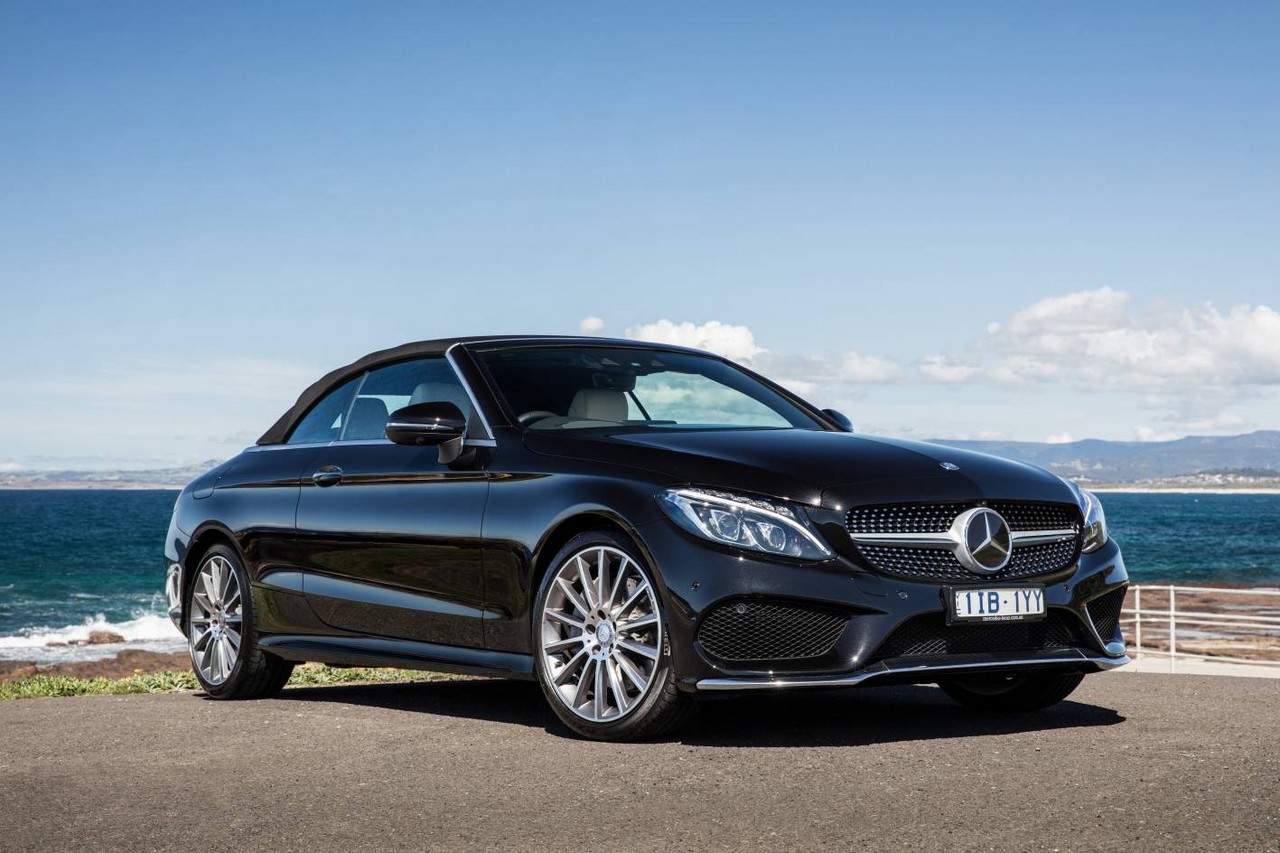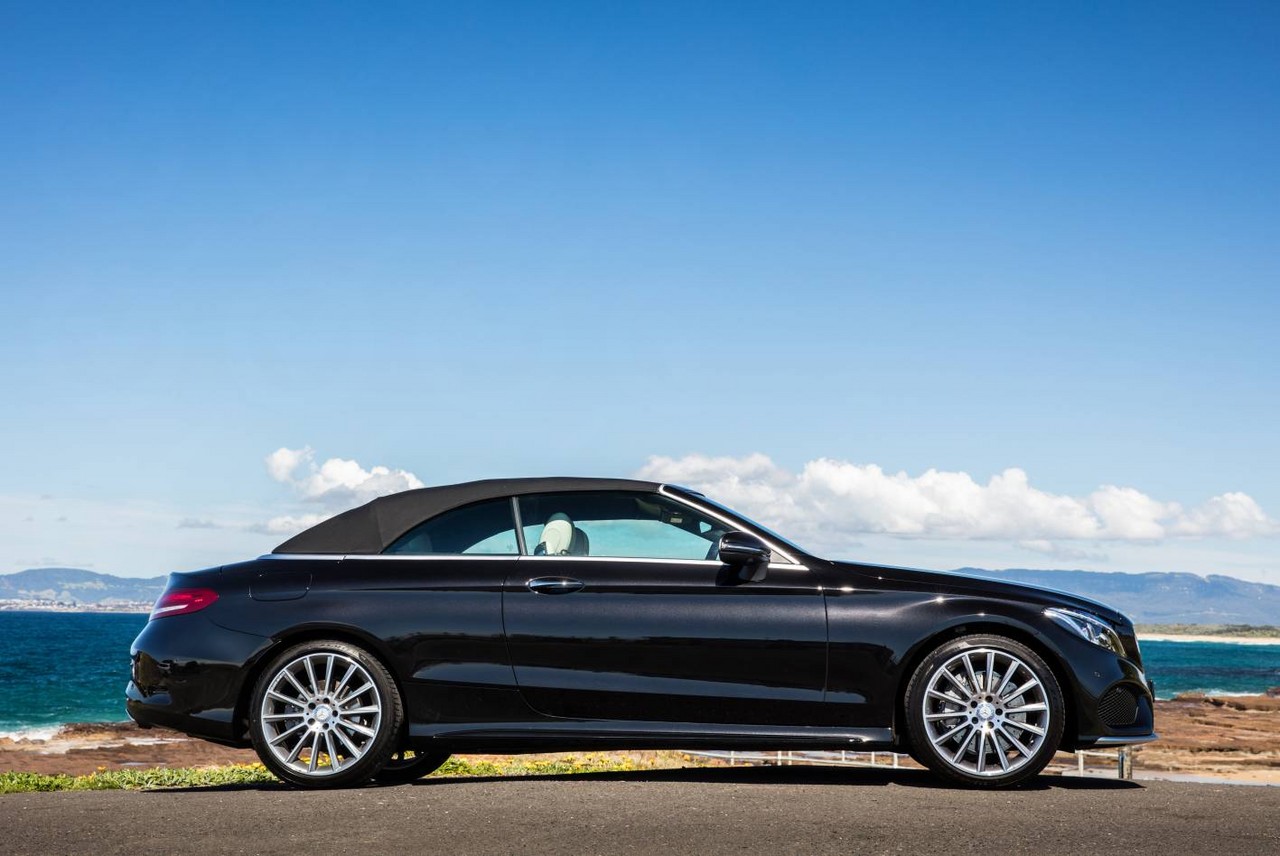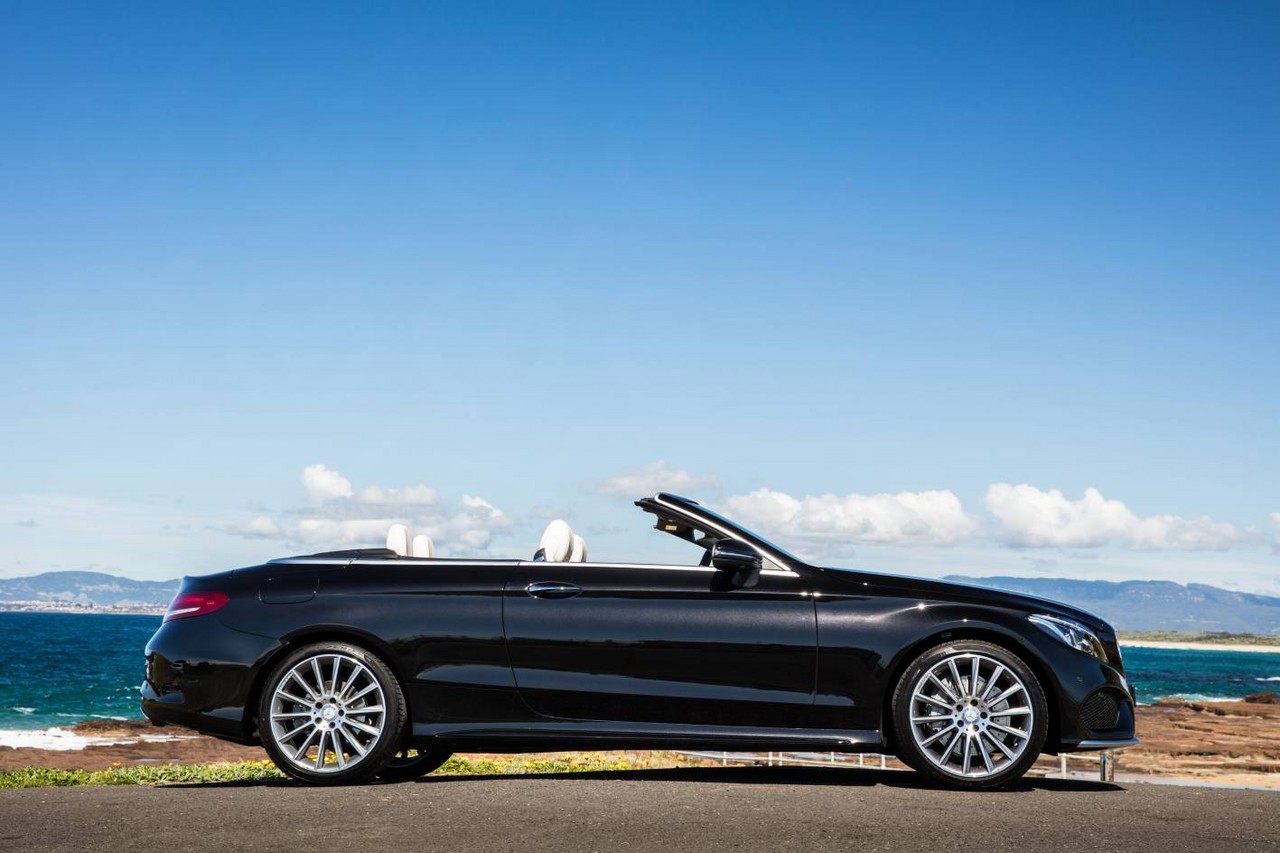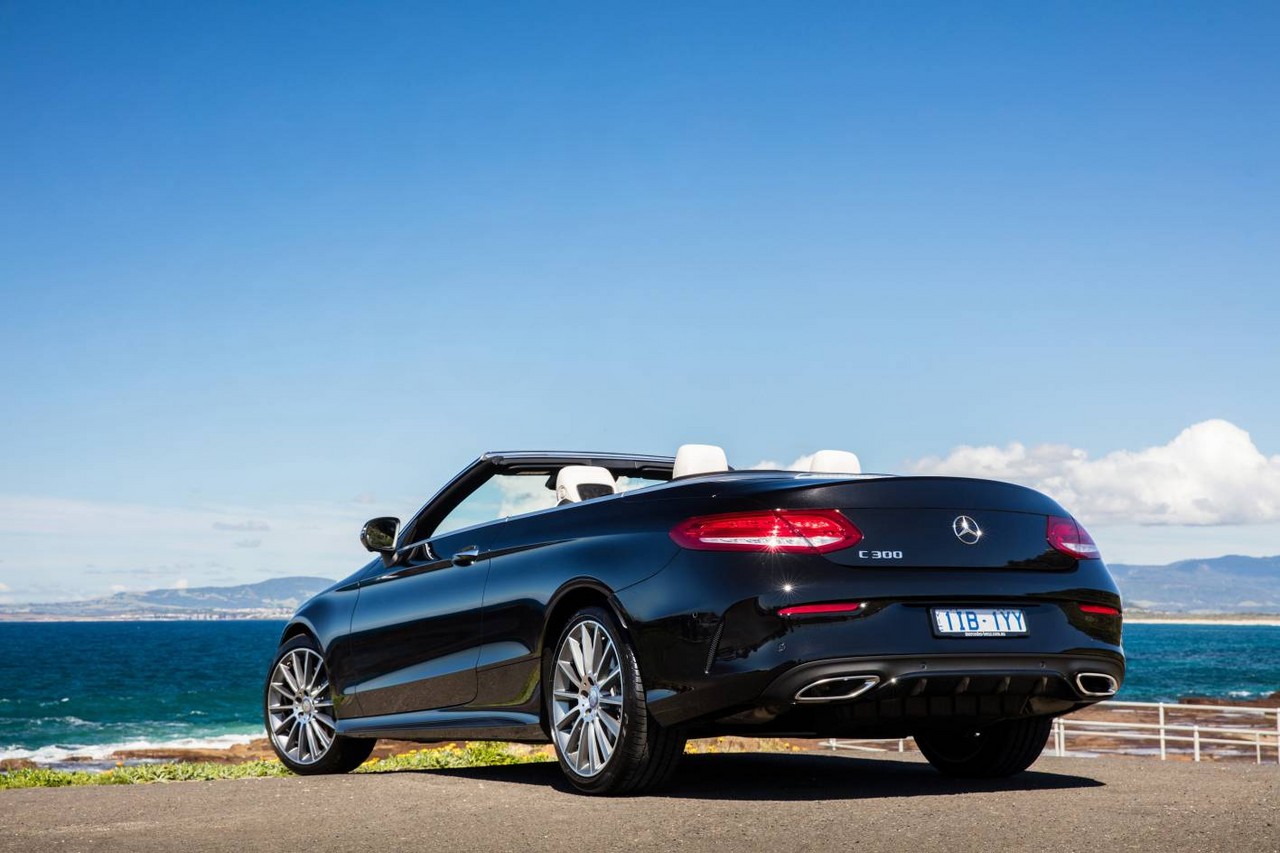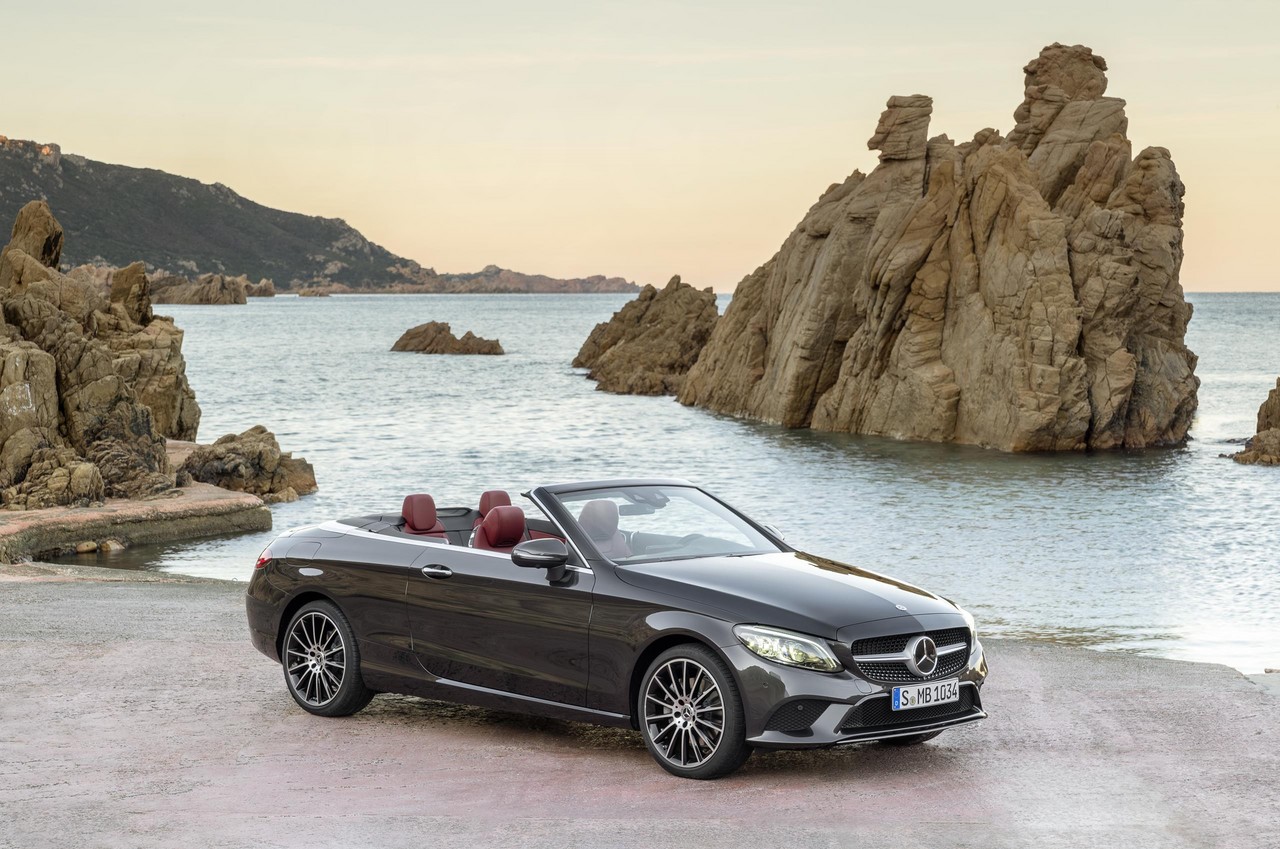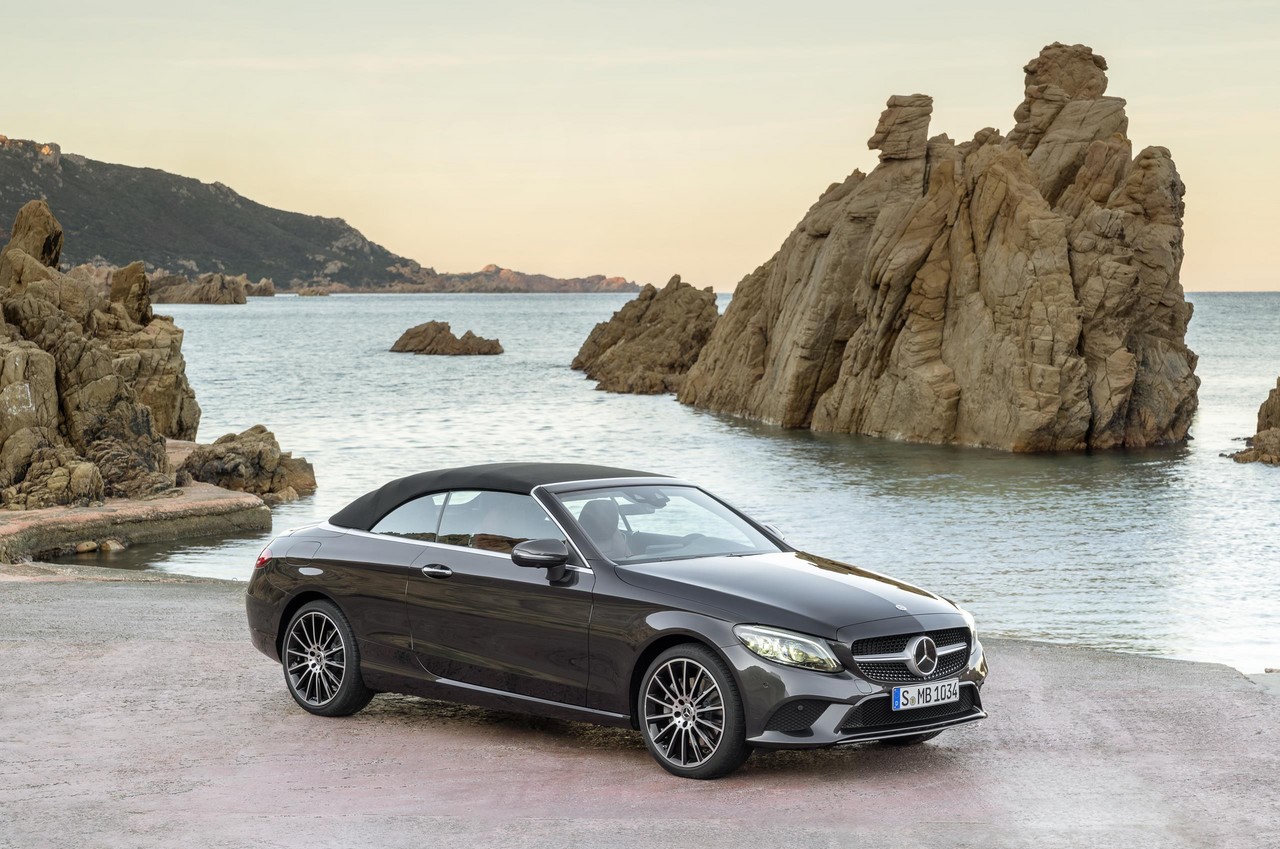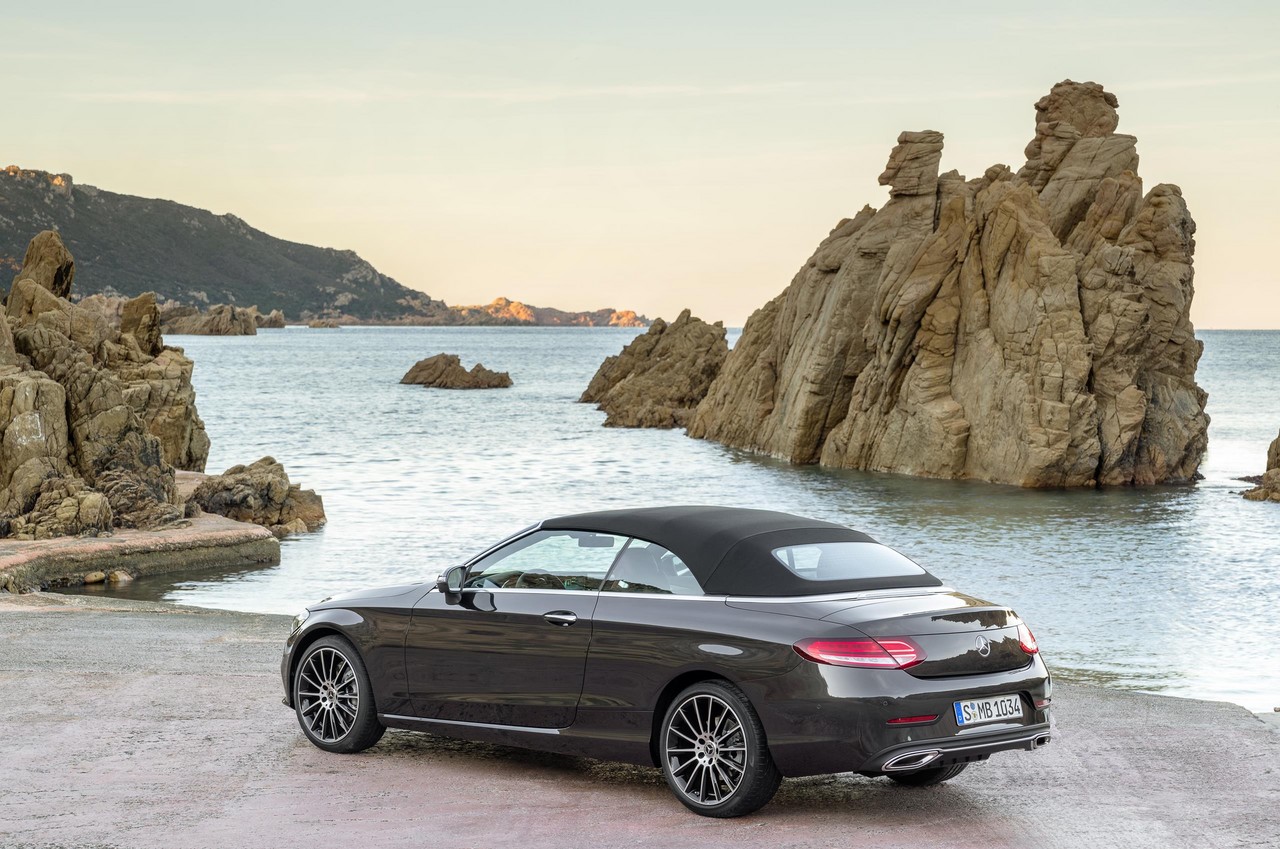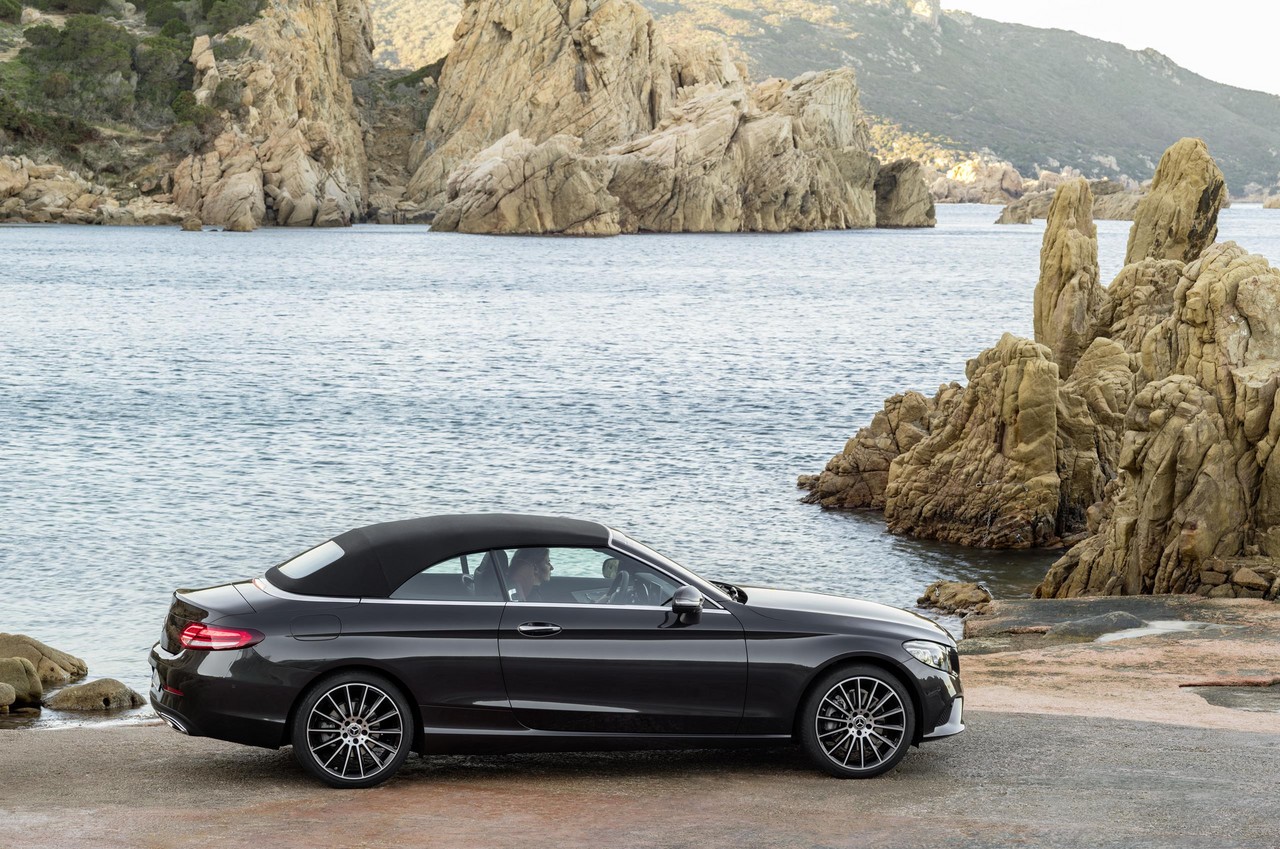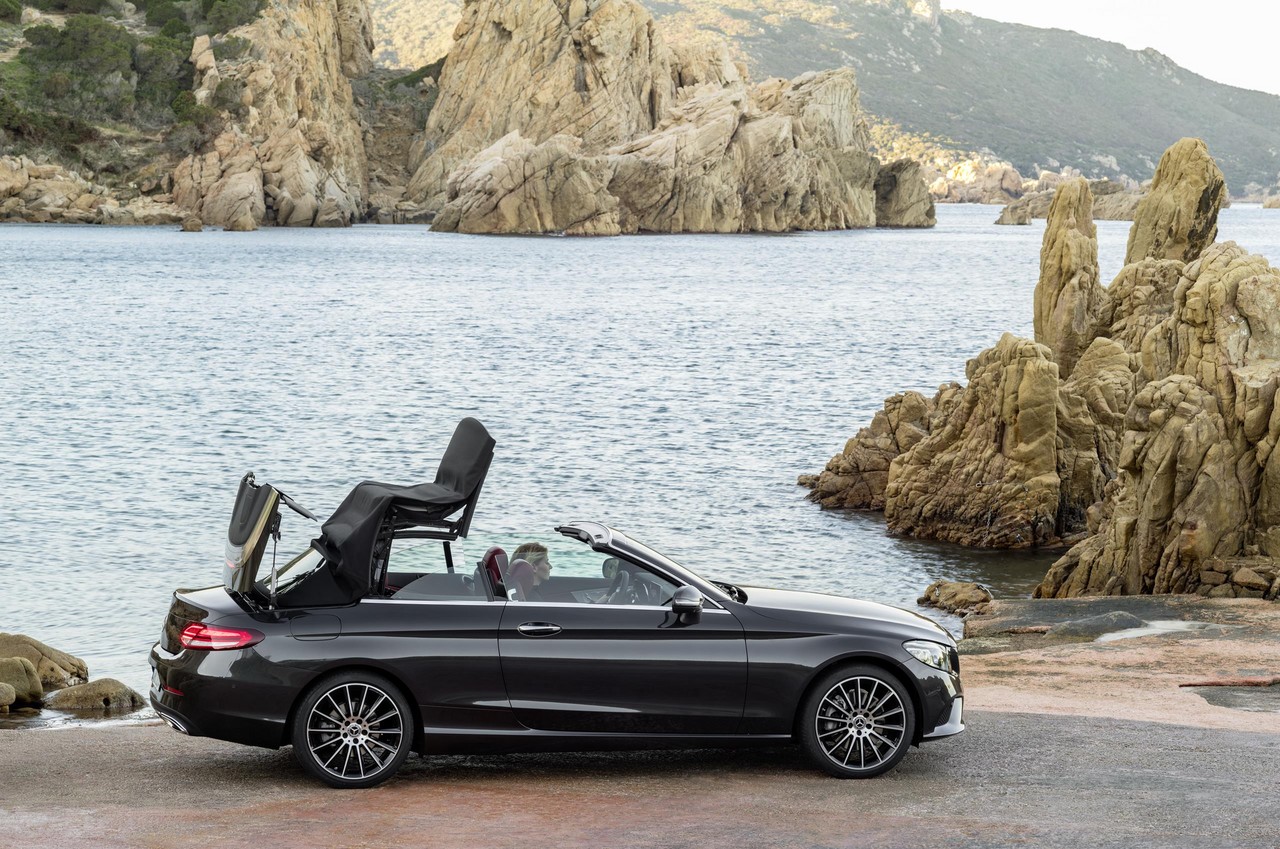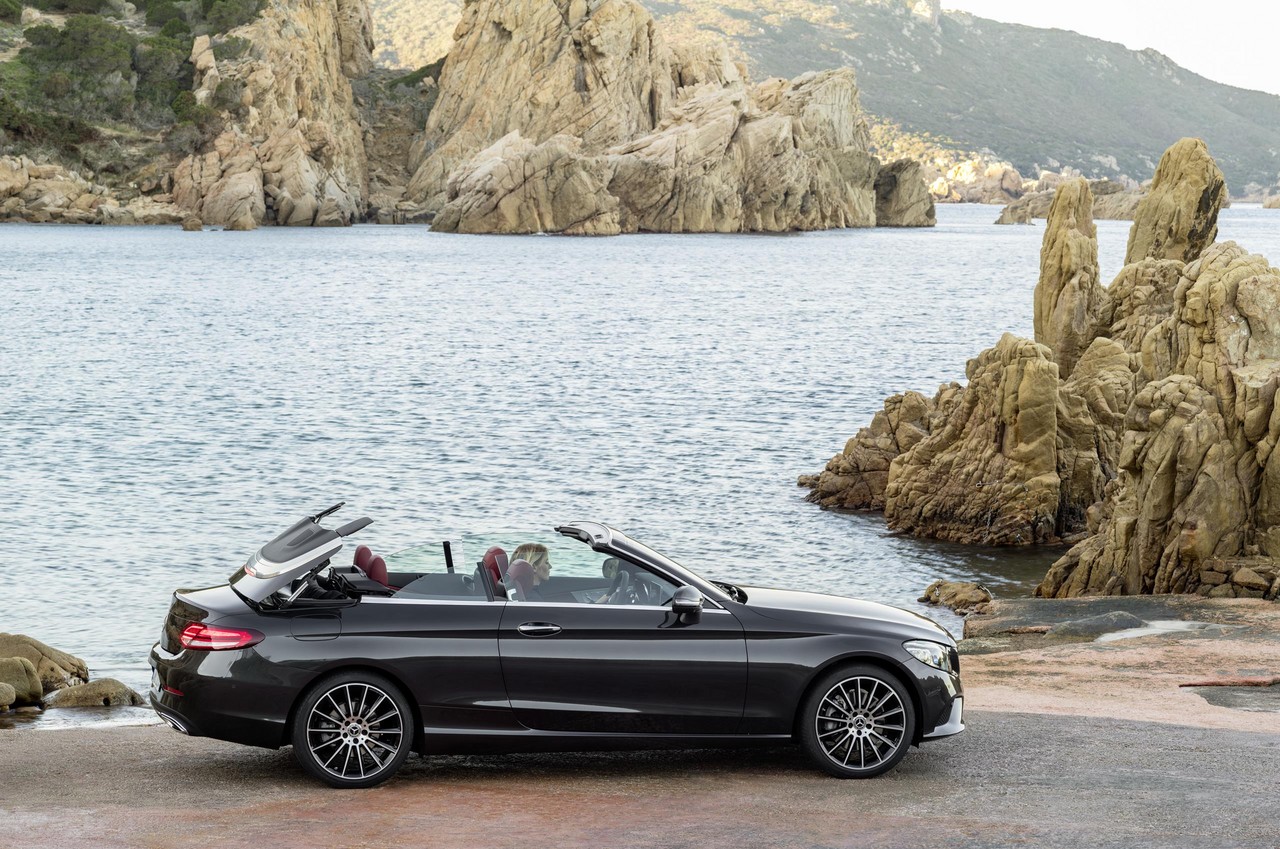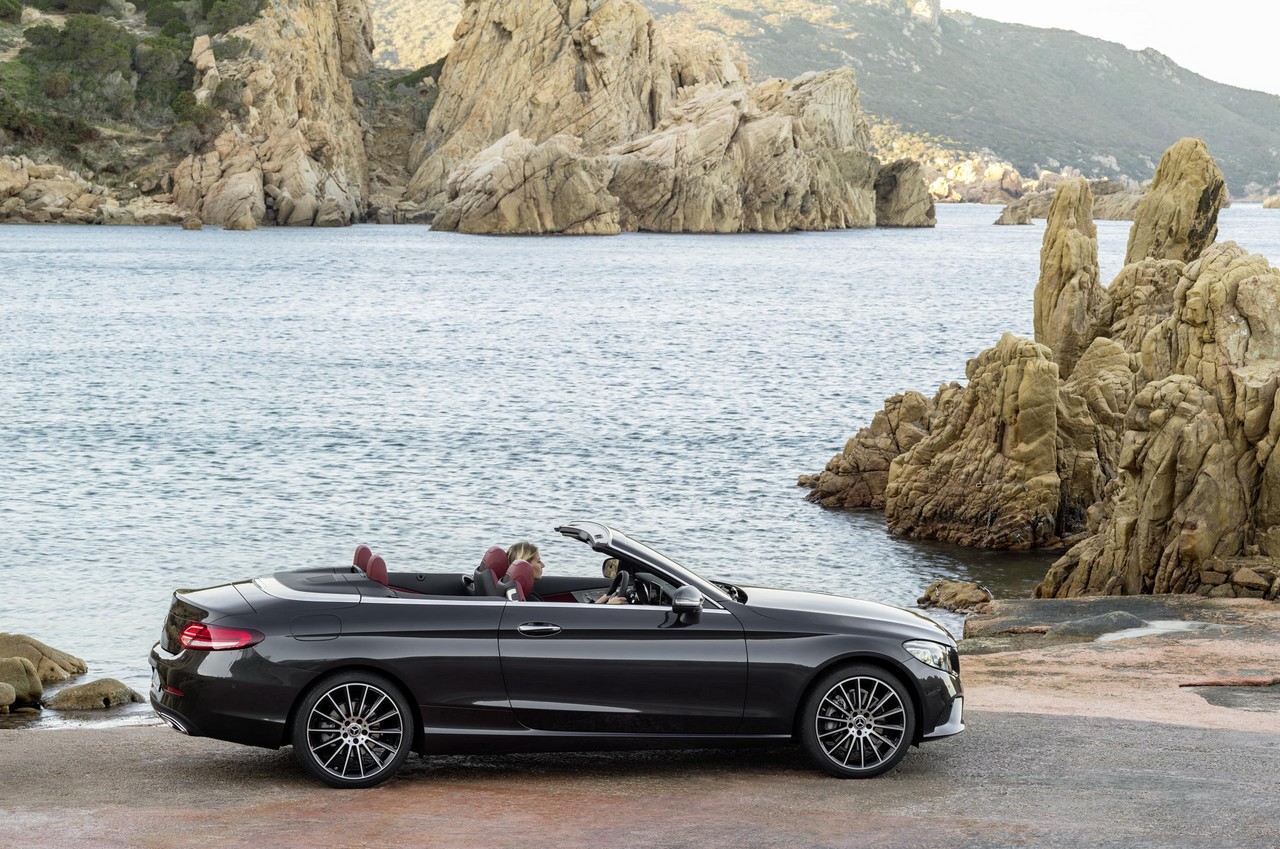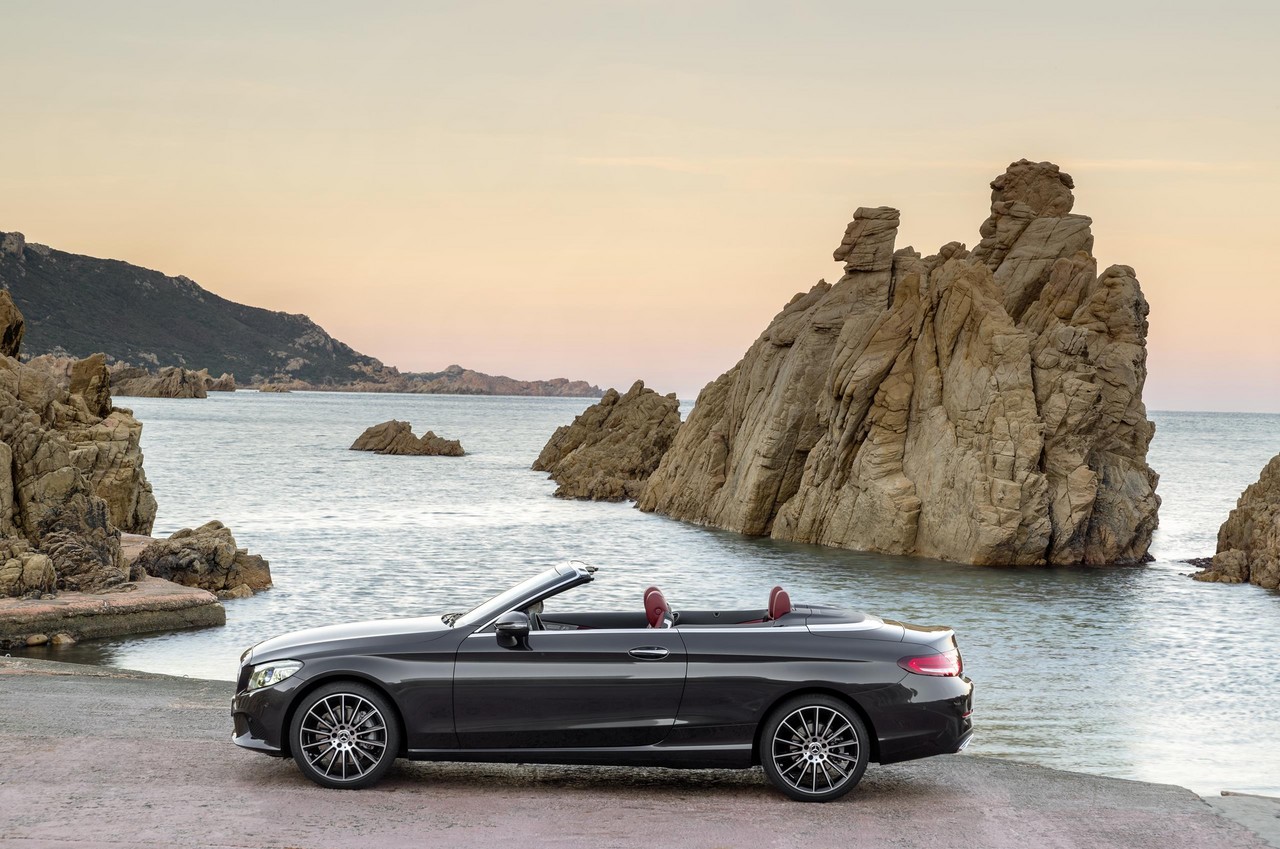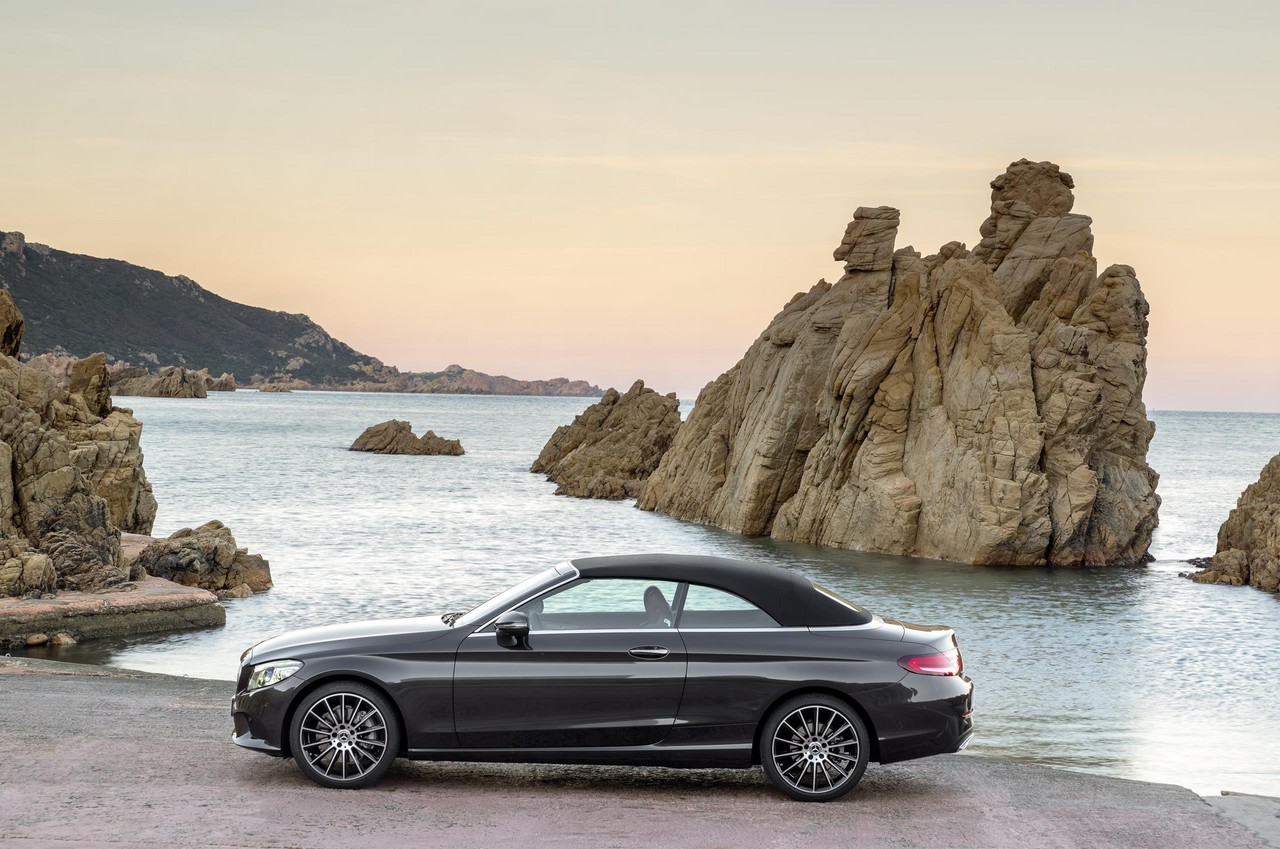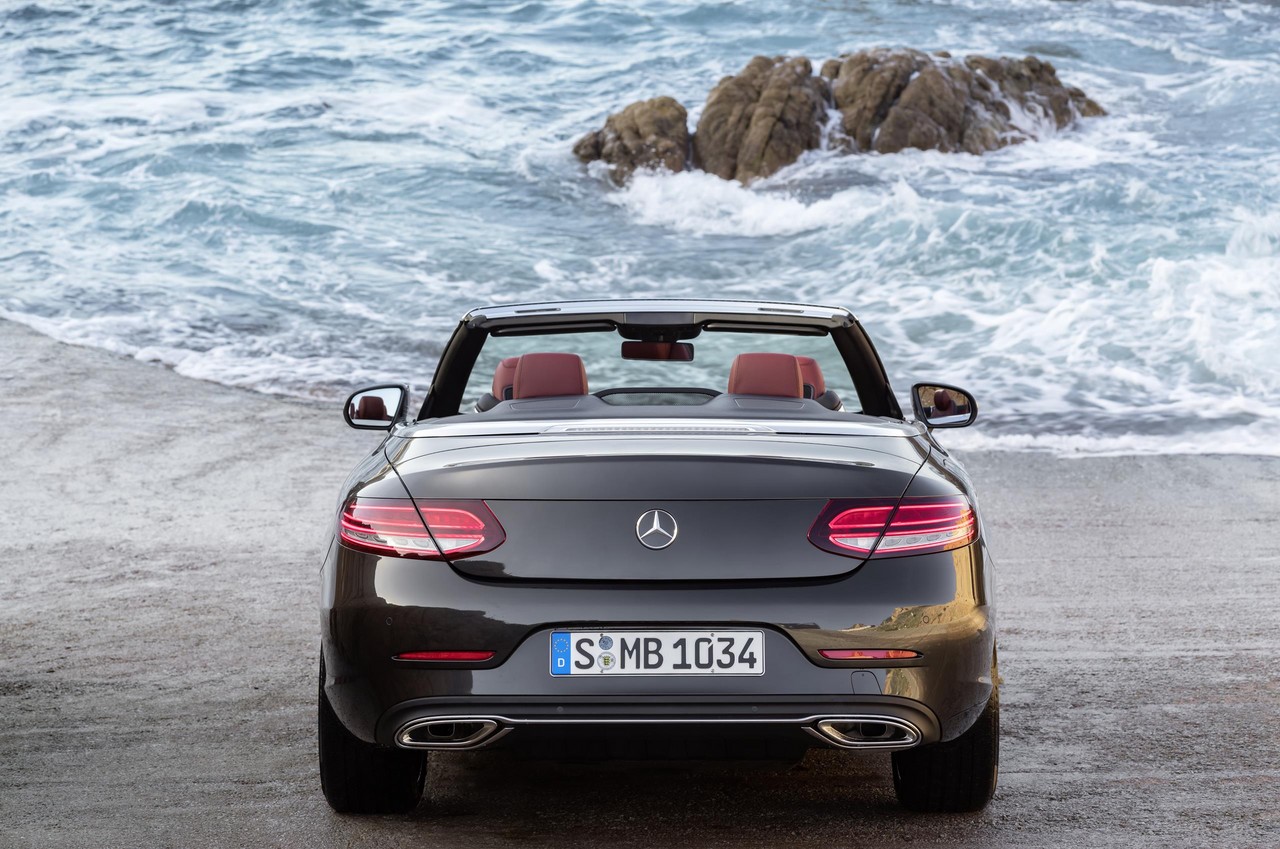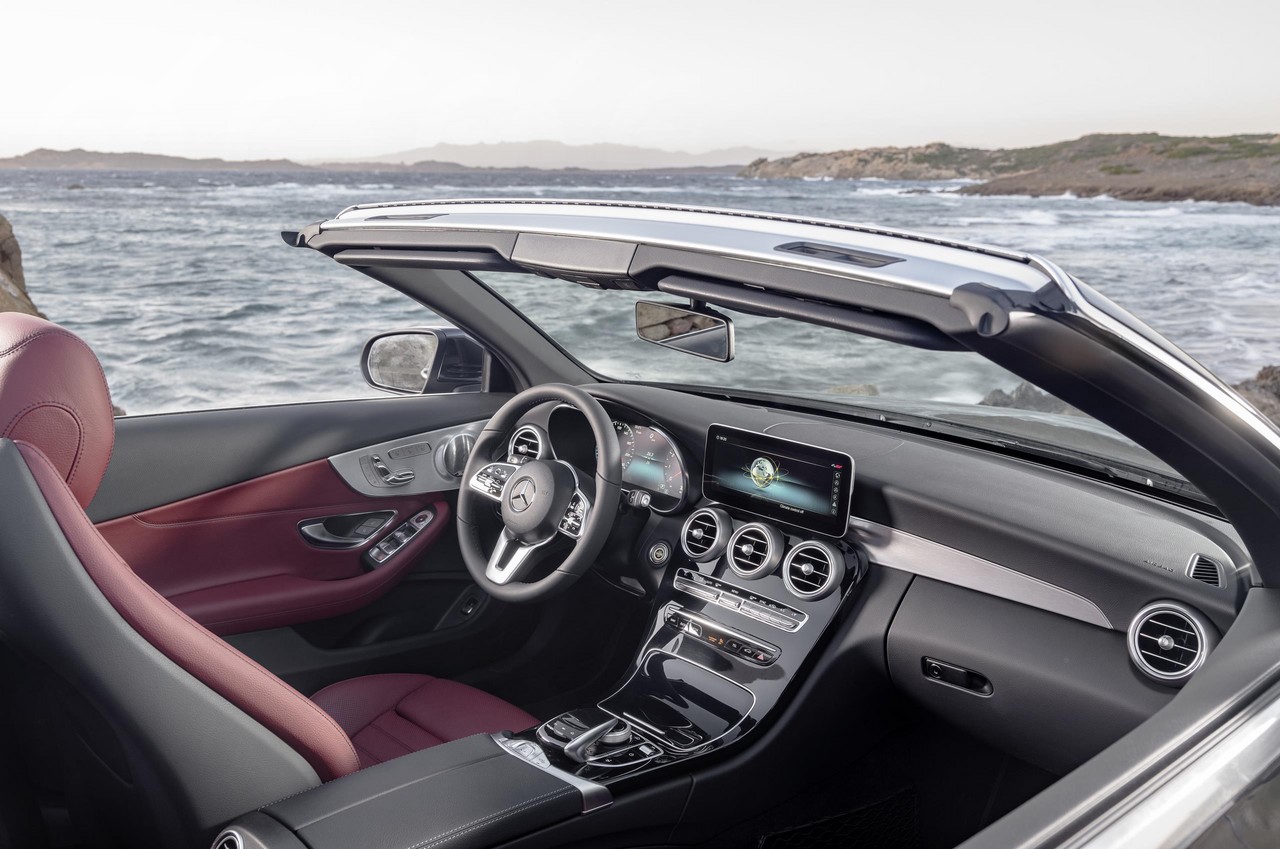
- Willing turbocharged petrol engines
- Well-weighted steering has good feedback (better than the BMW F32 4-Series)
- Refined nine-speed automatic transmission
- High standard of interior fit and finish
- Accomplished ride/handling balance
- … but 19-inch alloy wheels for C 300 hurt ride quality
- Geizig C 200 misses out on standard safety equipment of C 300
- Rear headroom unsuited to adults and poor rear legroom
- Shallow boot
Review: Mercedes-Benz A205.I C-Class Cabrio (2016-18)
Overview
Released in Australia in August 2016, the Mercedes-Benz A205 C-Class Cabriolet was a two-door, four-seat convertible with a fabric soft-top. Manufactured in Bremen, Germany, the rear-wheel drive Mercedes-Benz C-Class Cabriolet range for Australia consisted of the C 200 and C 300 models, both of which were powered by 2.0-litre turbocharged petrol engines and had nine-speed automatic transmissions (Mercedes-Benz’s ‘9G-Tronic’).
| Engine | Trans. | Peak power | Peak torque | |
|---|---|---|---|---|
| C 200 | 2.0-litre M274 turbo petrol I4 | 9sp auto | 135 kW at 5500 rpm | 300 Nm at 1200-4000 rpm |
| C 300 | 2.0-litre M274 turbo petrol I4 | 9sp auto | 180 kW at 5550 rpm | 370 Nm at 1300-4000 rpm |
Body and dimensions
The Mercedes-Benz A205 C-Class Cabriolet was based on the architecture of the W205 C-Class sedan and the front of the bodyshell and floor were designed to provide sufficient rigidity for a convertible. Compared to the C205 C-Class Coupe , the A205 C-Class Cabriolet had the same length (4686 mm), width (1810 mm) and wheelbase length (2840 mm), but had a 4 mm higher roofline (1409 mm). With the roof in position, the A205 C-Class Cabriolet had a drag coefficient of 0.28 Cd.
The standard fabric soft top for the C-Class Cabriolet was black, though a multi-layer ‘acoustic’ soft top was available in dark brown, dark blue, dark red or black colours. The soft-top roof could be opened or closed in less than 20 seconds and operated at speeds of up to 50 km/h. After opening, the roof folded down and was stored in a compartment in the boot. Boot capacity for the C-Class Cabriolet was 360 litres with the roof up and 285 litres with the roof stowed away.
Suspension and steering
The Mercedes-Ben A205 C-Class Cabriolet had four-link front and five-link rear suspension, with all shock absorbers mounted on aluminium die-cast components. As standard, the suspension included a selective damping system which adjusted the shock absorbers according to road and driving conditions (e.g. reduced damping in normal conditions for greater ride comfort and increased damping when cornering at speed to reduce body roll). Like the C205 C-Class Coupe , the suspension of the A205 C-Class Cabriolet was 15 mm lower than the W205 C-Class sedan .
As an extra-cost option, the C-Class Cabriolet was available with Mercedes-Benz’s ‘Airmatic’ air suspension which provided electronically controlled, continuously adjustable damping on the front and rear axles.
The Mercedes-Benz A205 C-Class Cabriolet had rack-and-pinion steering with electric power assistance.
Safety equipment
Standard safety equipment for the Mercedes-Benz A205 C-Class Cabriolet included dual front airbags, a driver’s knee airbag, front thorax/pelvis airbags, windowbags which are integrated in the top edges of the front door panels, ABS, electronic brake force distribution, brake assist, electronic stability control, traction control, cornering brake control and front seatbelts with pre-tensioners and load limiters.
Active safety technologies – fitted as standard – for the Mercedes-Benz C-Class Cabriolet included –
- Pre-Safe: in dangerous driving situations, Pre-Safe would prepare the vehicle by tensioning the front seat belts, closing the windows and sunroof (where fitted);
- Collision Prevention Assist Plus (radar-based collision warning with autonomous braking and adaptive Brake Assist): operating at speeds up to 250 km/h to monitor the traffic ahead and at speeds up to 50 km/h for stationary objects, Collision Prevention Assist would issue a visual warning (when driving at speeds over 7 km/h) and an optical warning (when driving at speeds over 30 km/h if there was a collision risk. At speeds below 105 km/h (250 km/h in conjunction with Distronic Plus), Collision Prevention Assist Plus would initially provide partial autonomous braking to reduce vehicle speed and alert the driver. Furthermore, adaptive Brake Assist would calculate the braking force required and prime the braking system for optimum response when the driver depressed the brake pedal. If the driver did not respond and a collision was unavoidable, then maximum braking force would be applied to reduce vehicle speed. At initial vehicle speeds of up to 40 km/h, rear-end collisions could be prevented;
- Blind spot assist (passive): used two radar sensors in the rear of the vehicle to warn the driver before an indicated lane-change if a vehicle was in the driver’s blind spot; and,
- Attention Assist: operated at speeds in excess of 80 km/h and assessed driver behaviour and steering movements for signs of drowsiness; if detected, the driver would be provided with visual and audible warnings.
Beyond this, however, the C 300 Cabriolet was further equipped with –
- Pre-Safe Brake with pedestrian detection (autonomous emergency braking): using two 24 GHz sensors behind the front bumper which had a range of 30 metres and a 77 GHz radar which had a range of 200 metres, Pre-Safe Brake operated at speeds between 30 km/h and 200 km/h, and at speeds below 70 km/h if the vehicle was approaching a stationary queue of traffic. Around 2.6 seconds before the anticipated moment of impact, an audible warning would sound and a red warning would appear in the tachometer. Around 1.6 before the calculated impact, the first stage of Pre-Safe Brake would initiate partial braking autonomously with around 40 per cent of the maximum braking power (approximately four (4) m/s2); the Pre-Safe occupant protections system would also be activated. If the driver then applied the brakes, maximum braking force would be made available. If the driver failed to react, Pre-Safe Brake would – in its second stage – initiate autonomous emergency braking (i.e. maximum braking power) around 0.6 seconds before the unavoidable collision to reduce the severity of the impact. The pedestrian recognition function enabled Pre-Safe Brake to detect pedestrians when driving at speeds of up to 50 km/h;
- Pre-Safe Plus: could anticipate potential rear-end collisions and warn following traffic by flashing the rear hazard lights at high frequency. The Pre-Safe Plus system would then deploy occupant protection measures and apply the vehicle’s brakes to prevent secondary accidents;
- BAS Plus with Cross-Traffic Assist: used a 24 GHz radar sensor with a range of 30 metres and a 77 GHz radar sensor with a range of 200 metres to monitor the distance to the vehicle ahead and would warn the driver if there was a risk of a collision. Brake Assist Plus could detect vehicles when travelling at speeds up to 200 km/h, and stationary objects when the driver was travelling at 7 km/h to 72 km/h. Significantly, Brake Assist Plus could calculate the necessary brake force assistance to prevent a rear-end collision, build up that pressure in the braking system and provide it as soon as the brake pedal was depressed for ‘the best possible deceleration’. The Cross-Traffic Assist function could operate at speeds up to 72 km/h and used the stereo camera and radar sensors to detect traffic that was crossing in front of or behind the vehicle. If detected, the driver would receive visual and audible alerts;
- Distronic Plus (adaptive cruise control with brake warning): an ‘adaptive’ cruise control system which used two short-range radar sensors positioned behind the front bumper to monitor the road up to 30 metres ahead, and a long-range radar located behind the radiator grille which had a range of 200 metres. Operating at speeds up to 200 km/h, Distronic Plus used an electronic control unit to analyse the information from both radar systems to calculate the engine, automatic transmission and braking parameters required for proximity control. As such, Distronic Plus could automatically apply the brakes to prevent the vehicle from becoming too close to traffic ahead (the time interval could be specified) and accelerate back to the set speed when traffic allowed. To accelerate from rest, the driver only needed to operate the Distronic stalk on the steering column or briefly depress the accelerator pedal. With Distronic Plus, automatic deceleration of up to four (4) m/s2was possible. If Distronic Plus detected that heavier braking was required, a warning light would illuminate in the instrument cluster and be accompanied by an audible warning. Furthermore, the electronic proximity control system could be activated independently of Distronic Plus at speeds over 30 km/h to alert the driver if they were approaching another vehicle too rapidly;
- Steering Assist with Stop&Go Pilot: operating in conjunction with Distronic Plus and at speeds up to 130 km/h, Steering Assist used a stereo camera located behind the windscreen to detect road markings, while the Stop&Go Pilot operated at speeds up to 60 km/h and enabled the system to use the vehicle in front or road markings as a means of orientation. If the vehicle was detected to be drifting out of its lane, Steering Assist would warn the driver and provide steering intervention to keep the vehicle in its lane;
- Active Blind Spot Assist: active at speeds above 60 km/h, a corrective braking force would be applied to the wheels on one side of the vehicle if the driver attempted to change lanes when a vehicle was detected in the driver’s blind spot; and,
- Active Lane Keeping Assist: could prevent the vehicle from unintentionally drifting out of the lane by applying the brakes on one side of the vehicle.
As standard, the Mercedes-Benz A205 C-Class Cabriolet had an ‘active bonnet’ which, in the event of a pedestrian collision, triggered a pyrotechnic charge to raise the height of the bonnet and provide additional clearance to ‘hard points’ within the engine bay.
Euro NCAP testing
In Euro NCAP testing , the Mercedes-Benz A205 C-Class Cabriolet received a five star safety rating which included an 89 per cent adult occupant protection rating and a 79 per cent child occupant protection rating. In the frontal offset test, protection of the front occupants was generally rated as good, although lower leg protection for the driver was rated as adequate (i.e. a slight risk of serious injury). In the side impact test, driver protection was rated as good in all body areas; in the more severe pole test, however, chest protection was rated as weak (i.e. a significant risk of serious injury).
Features: Mercedes-Benz A205 C 200 Cabriolet
Standard features for the Mercedes-Benz C 200 Cabriolet included 18-inch five-spoke alloy wheels with run-flat tyres, an ‘Audio 20’ sound system with five speakers, a seven-inch TFT display, digital radio tuner (DAB+), CD player, MP3/WMA/AAC compatibility, Bluetooth mobile phone connectivity and audio streaming, a Garmin MAP PILOT navigation system, dual-zone climate control air conditioning (‘Thermatic’), leather upholstery, power adjustable front seats with memory settings, cruise control, a head-up display, front and rear parking sensors, dusk-sensing headlights, rain-sensing wipers, a leather-wrapped steering wheel with gearshift paddles, 50:50 split folding rear seats, remote central locking, power adjustable and heated door mirrors with folding function, a height and reach adjustable steering wheel, push-button start, an auto-dimming rear view and driver’s side door mirror, an electrically operated park brake ambient interior lighting, AMG floor mats, AMG sports pedals, black roof liner, tyre pressure monitoring, a trip computer and an immobiliser.
The C 200 Cabriolet was also fitted with the following Mercedes-Benz technologies –
- LED Intelligent Light System with Adaptive Highbeam Assist Plus: allowed the main LED beam to remain on when traffic was approaching since a portion of that beam could be masked out to avoid dazzling other drivers. Also included five selectable programs: motorway mode, cornering light function, camera-based active light function, roundabout light function and enhanced fog light function;
- Active Parking Assist: could identify parallel and right angle parking spaces – at speeds of up to 35 km/h – and automatically steer the vehicle into the space while the driver controlled vehicle speed;
- AIRCAP automatic draught-stop: consisted of an extendable wind deflector with a net that was set into the roof frame and an extendable draught-stop behind the rear seats; and,
- A 360 degree camera system which could show the C-Class Cabriolet and its surroundings from different perspectives.
Features: Mercedes-Benz A205 C 300 Cabriolet
Compared to the C 200 Cabriolet, the C 300 Cabriolet was further equipped with Mercedes-Benz’s COMAND Online infotai Nment system which had a 21.3 cm TFT colour display, HDD navigation with live traffic updates, CD/DVD player, 10 GB music register, Bluetooth interface, voice recognition (‘Linguatronic’) and internet access.
Other standard features for the Mercedes-Benz A205 C 300 Cabriolet included 19-inch fourteen-spoke alloy wheels, a 590 watt Burmester surround system with thirteen speakers and a nine-channel digital sound processing amplifier, heated front seats, proximity key (‘Keyless go’), ‘Airscarf’ neck-level heating for front occupants and a sports exhaust system.
Specifications
Related links
Review: Mercedes-Benz A205.II C-Class Cabrio (2018-23)
Overview
Released in Australia in August 2018, the Mercedes-Benz A205.II C-Class Cabriolet introduced a revised range that initially consisted of C 200 EQ Boost models, with the C 300 following in October 2018.
The A205.II C-Class Cabriolet introduced a new ‘electronic architecture’. For the C 200 EQ Boost, this electronic architecture enabled it to have an additional 48 volt onboard network and a belt-driven starter/alternator for fast restarts and low vibrations. Furthermore, ‘EQ Boost’ provided the following functions:
- When accelerating, EQ Boost could assist the engine with an additional 10 kW until the turbocharger accumulated full charge pressure;
- The EQ Boost function would also assist the engine to reach its ideal operating speed as quickly as possible during gearshifts to reduce shift times;
- During deceleration, the starter/alternator would recuperate kinetic energy and charges the battery;
- The water pump was electrically driven and actuated by a characteristic map to adapt cooling output according to need; and,
- Below a certain speed, a ‘glide mode’ would decouple the engine from the drivetrain to avoid engine braking and the engine would switch off to reduce fuel consumption.
Visually, the Mercedes-Benz A205.II C-Class Cabriolet could be identified by its redesigned front bumper, AMG bodystyling with diamond radiator grille and front and rear lamps were ‘defined by clear-lined contours’.
| Engine | Trans. | Peak power | Peak torque | |
|---|---|---|---|---|
| C 200 EQ Boost | 1497 cc M264 turbo petrol I4 | 9sp auto | 135 kW at 5800-6100 rpm, plus 10 kW EQ Boost | 280 Nm at 3000-4000 rpm |
| C 300 | 1991 cc M264 turbo petrol I4 | 9sp auto | 190 kW at 5500 rpm | 370 Nm at 1800-4000 rpm |
Safety equipment
The Mercedes-Benz A205.II C-Class Cabriolet introduced improved camera and radar systems. For example,
- The forward-facing camera had a maximum range of 500 metres, including 90 metres in 3D; and,
- The vehicle’s surroundings would be scanned by radar across a distance of up to 250 metres to the front, 40 metres to the sides and 80 metres to the rear.
For the A205.II C-Class Cabriolet, ‘Collision Prevention Assist Plus’ was effectively renamed ‘Active Brake Assist’.
Features: C 200 EQ Boost and C 300 Cabriolet
For the Australian-delivered Mercedes-Benz A205.II C-Class Cabriolet, standard features were extended to include:
- A 12.3-inch (1920 x 720 pixel) fully digital instrument display;
- A 10.25-inch (1920 x 720 pixel) central display for the Audio 20 infotainment system (previously seven-inch);
- An SD card navigation system (replacing the Garmin Map Pilot navigation system);
- Apple CarPlay and Android Auto smartphone integration; and,
- Touch-sensitive steering wheel controls.
For a complete list of features for the Mercedes-Benz A205.II C 200 EQ Boost and C 300 Cabriolet, please refer to ‘Specifications’, below.
Specifications
